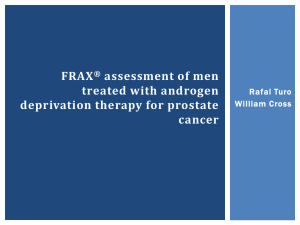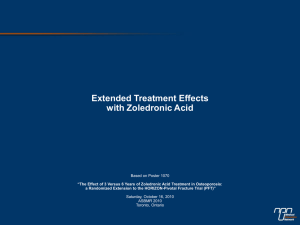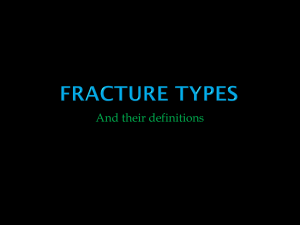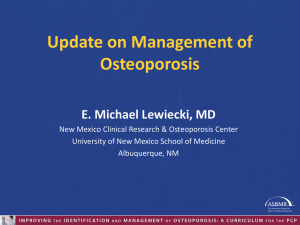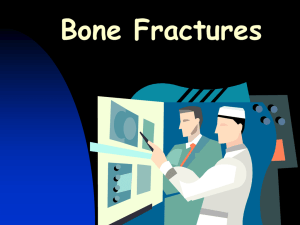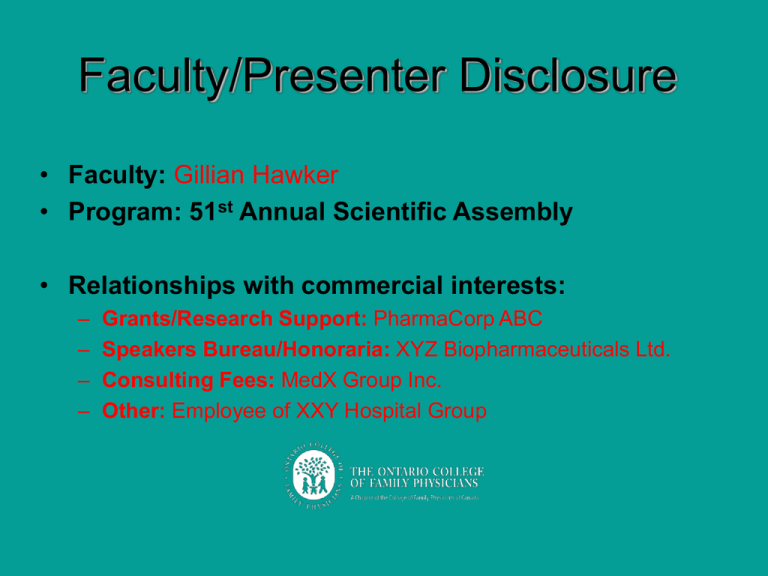
Faculty/Presenter Disclosure
• Faculty: Gillian Hawker
• Program: 51st Annual Scientific Assembly
• Relationships with commercial interests:
–
–
–
–
Grants/Research Support: PharmaCorp ABC
Speakers Bureau/Honoraria: XYZ Biopharmaceuticals Ltd.
Consulting Fees: MedX Group Inc.
Other: Employee of XXY Hospital Group
Disclosure of Commercial
Support
• This program has received financial support [ organization
name] from in the form of [describe support here – e.g. an
educational grant].
• This program has received in-kind support from [organization
name] in the form of [describe support here – e.g. logistical
support].
• Potential for conflict(s) of interest:
– [Speaker/Faculty name] has received [payment/funding, etc.]
from [organization supporting this program AND/OR organization
whose product(s) are being discussed in this program].
– [Supporting organization name]
[developed/licenses/distributes/benefits from the sale of, etc.] a
product that will be discussed in this program: [insert generic and
brand name here].
Mitigating Potential Bias
• [Explain how potential sources of bias identified in slides
1 and 2 have been mitigated].
• Refer to “Quick Tips” document
Bone Mineral Density Testing:
Who, When and What For?
Dr Gillian Hawker
Ontario College of Family Physicians
Annual Scientific Assembly
November 28-30, 2013
Disclosures
• Contract from the Ontario MOHLTC
Osteoporosis Strategy
Outline
• Why do we assess Bone Mineral Density
(BMD)?
• How do we assess BMD?
• What are the pitfalls of BMD testing?
• When should BMD be assessed?
• What is the role of BMD in fracture risk
assessment / treatment decision making?
Ontario College of Family Physicians Annual Scientific Assembly
WHY ORDER A BMD TEST?
Why order a BMD test?
• To make a diagnosis of osteoporosis / low
bone mass in high risk populations
– Younger people with medical conditions, e.g.
celiac disease, IBD on steroids, cancer
chemotherapy
• To evaluate fracture risk in patients at
increased risk for fracture
– Older people
How do we assess BMD?
• DXA = dual energy x-ray absorptiometry
• Measures BMD at:
– Lumbar spine (L1-L4)
– Hip
• Femoral neck
• Total hip
– Radius
– Total body
• Low radiation exposure
What does DXA measure?
Bone Quantity
Bone Quality
– BMD
– bone size
– bone mass
– architecture
– bone turnover
– bone properties
mineralization
micro-damage
DXA measures the
Bone
Strength
=
density of bone
Bone
Quantity + Bone Quality
mineral
Two types of bone
• Trabecular bone:
• 20% of total bone, 80%
of bone turnover
• Cortical bone:
• 80% of bone, 20% of
bone turnover
Most susceptible
to effects of illness
May be relatively
preserved when spine
BMD
11
What are we measuring?
Measurement Site:
Trabecular Bone
Cortical Bone
Lumbar spine
++
+
Femoral neck
+
++
Total hip
+
++
Radius
++
++
Ontario College of Family Physicians Annual Scientific Assembly
POTENTIAL PITFALLS OF DXA
Limitations of DXA
• Not portable
• Doesn’t provide any information about bone
architecture, which can influence fracture risk
independent of BMD
• Many factors interfere with accuracy (technical
issues, artifact)
• Measures calcium mineral in bone, thus may be falsely
low with vitamin D deficiency (unmineralized bone)
• Cost
Factors Affecting BMD Accuracy
• Test Performance
– Technical Problems
• Positioning of patient
• Estimating “density” from two dimensions
– Artifact
•
•
•
•
Spine degenerative change (extra bone)
Changes in body mass
Hardware
Fracture
Some Examples…
Degenerative changes in spine
L1 compression fracture
Hip positioning
Hip rotation – lesser trochanter visible – c.w. baseline scan,
shows 9.5% loss
Hip positioning changed
Now, compared with baseline scan, no significant change!
Ontario College of Family Physicians Annual Scientific Assembly
WHEN SHOULD BMD BE
ASSESSED?
Screening versus Case Finding
• Screening:
– Entire population tested irrespective of ‘risk
factors’, e.g. mammography at age 50
• Men and women age 65+ years
• Case Finding:
– Test subset of the population based on presence /
absence of risk factors
• BMD testing in men and women < 65 years of age
– 50-64 years
– < 50 years
Case Finding Approach
Clinical risk factors
Assess OP / fracture risk
Low risk
Reassure
Moderate-High risk
Assess bone density
Calculate fracture risk
Low
Reassure
Moderate-High
Consider Rx
Indications for BMD Testing in Older
Adults 2010 Osteoporosis Canada Guidelines
• All women and men age > 65
Indications for BMD Testing in Adults
50-64 Years 2010 Osteoporosis Canada Guidelines
• Postmenopausal women & men aged 50 – 64 with clinical
risk factors for fracture:
–
–
–
–
–
–
–
–
–
–
Fragility fracture after age 40
Prolonged glucocorticoid use†
Other high-risk medication use*
Parental hip fracture
Vertebral fracture or low bone mass on X-ray
Current smoking
High alcohol intake
Low body wt (<60 kg) or major wt loss (>10% weight at age 25)
Rheumatoid arthritis (inflammatory arthritis)
Other disorders strongly associated with osteoporosis
†≥
3 months in prior year at dose ≥ 7.5 mg daily;
* e.g. aromatase inhibitors, androgen deprivation therapy.
These risk factors largely based on
unadjusted estimates in women
aged > 65 years
4/13/2015
What About Women at
Menopause?
• Systematic literature review of risk factors for low
BMD/fracture in healthy women aged 40-60 years
• Results
– Good evidence: low body weight and post-menopausal status
– Good or fair evidence: alcohol and caffeine intake, reproductive
history are not risk factors
– Inconsistent or insufficient evidence: calcium intake, physical
activity, smoking, age at menarche, history of amenorrhea, family
history of OP, race and current age on BMD
Waugh et al, Osteoporosis International 2009
Risk Factors for Low BMD in Women at
Menopause
• In healthy women 40-60 years having first BMD test,
determined the combination of risk factors that best
discriminated women with/without low bone mass (T-score ≤ 2.0)
• 944 eligible women (77%) participated
– 87 (9.2%) had low bone mass (35 pre-/peri- + 52 post-menopausal)
• Four independent risk factors identified:
–
–
–
–
weight of ≤70 kg
older age
> number of years post menopause
fragility fracture after age 40
Hawker G et al Osteoporosis International 2012
Indications for BMD Testing for
Individuals Under Age 50 Years
• Clinical risk factors for osteoporosis / bone loss or
fracture
Making a Diagnosis of Low Bone
Mass or Osteoporosis
Age
Category
Criteria*
Below expected range for age
Z-score < -2.0
Within expected range for age
Z-score > -2.0
Severe (established)
osteoporosis
T-score < -2.5 with fragility
fracture
Osteoporosis
T-score < -2.5
Low bone mass
T-score -1.1 to -2.4
Normal
T-score > -1.0
< 50 years
> 50 years
Which T score to use?
• BMD reporting is based upon lowest value for
lumbar spine (minimum two vertebral levels), total hip,
and femoral neck
– If either the lumbar spine or hip is invalid, then the
forearm should be scanned and the distal one-third
radius reported
Ontario College of Family Physicians Annual Scientific Assembly
ROLE OF BMD TESTING IN
FRACTURE RISK ASSESSMENT
Value of BMD Assessment
• Key risk factor for fracture
– We treat fracture risk not bone density!
• Baseline assessment in those with
conditions/ treatments associated with
accelerated bone loss
• ‘Fragility fracture’ work up
Absolute 10-year Fracture-Risk Tools
• Tools validated in Canada (choice based on
personal preference and convenience)
– CAROC: Joint initiative of the Canadian Association of
Radiologists and Osteoporosis Canada1
– FRAX: Fracture Risk Assessment Tool developed by
the World Health Organization2
• There are large differences in fracture rates from
country to country3-5
– Assessment tools need to be country specific
1. Leslie WD, Berger C, et al. Osteoporosi Int; In press..
2. Leslie WD, Lix LM, et al. Osteoporosi Int; In press.
3. Kanis JA, et al. J Bone Miner Res 2002; 17(7):1237-1244.
4. Melton LJ, III. Endocrinol Metab Clin North Am 2003; 32(1):1-13.
5. Leslie WD, et al. J Bone Miner Res 2010; in press.
Variations in Estimated FRAX 10-Year
Fracture Probabilities According to Country
Canada
10-Year Major Fracture Probability
Age 65 years, prior fracture with femoral neck T-score -2.5
30
Female
Male
20
15
10
Turkey
China
Lebanon
Spain
US Black
New Zealand
France
US Asian
US Hispanic
Germany
Finland
Hong Kong
Argentina
Italy
Japan
Belgium
CANADA
United Kingdom
Austria
US Caucasian
0
Switzerland
5
Sweden
Percent fracture
25
Version 3.1 FRAX website (www.sheffield.ac.uk/FRAX
10-Year Hip Fracture Probability
Age 65 years, prior fracture with femoral neck T-score -2.5
10-year Risk Assessment: CAROC
• Provides estimate of 10-year absolute risk of a
major osteoporotic fracture* in postmenopausal
women and men over age 50 (no Rx) based on
age, sex, and T-score at the femoral neck
– Low: < 10%
– Moderate 10-20%
– High: > 20%
* Including hip, spine, forearm, and proximal humerus
Siminoski K, et al. Can Assoc Radiol J 2005
10-year Risk Assessment for Women
(CAROC Base Risk)
Papaioannou A, et al. CMAJ 2010
10-year Risk Assessment for Men
(CAROC Base Risk)
Risk Assessment with CAROC:
Important Additional Risk Factors
• Factors that increase CAROC
risk by one category (i.e., from low
to moderate or moderate to high)
– Fragility fracture after age 40*
– Recent prolonged systemic
glucocorticoid use
* Hip, vertebral fracture, or multiple fracture events should be
considered high risk
Siminoski K, et al. Can Assoc Radiol J 2005; 56(3):178-188.
Kanis JA, et al. J Bone Miner Res 2004; 19(6):893-899.
Impact of Prior Vertebral Fracture
on Risk Assessment
• Vertebral fractures unrelated to trauma are
associated with a 5X risk for another
vertebral fracture
• A fracture detected from x-ray alone should
be considered a prior fracture
If moderate fracture risk, consider spine xray to rule out VF
Risk Assessment Using FRAX
• Uses age, sex, femoral neck BMD, and additional
clinical risk factors to calculate 10-year fracture
risk (composite* and hip only)
– Additional risk factors: parental hip fracture, prior
fracture, glucocorticoid use, current smoking, high
alcohol intake, rheumatoid arthritis
• Validated for use in Canada
• Online FRAX calculator: www.shef.ac.uk/FRAX
* composite of hip, vertebra, forearm, and humerus
Leslie WD, et al. Osteoporos Int.
FRAX Tool: On-line Calculator
www.shef.ac.uk/FRAX.
Issue with Reliance on Hip BMD
CAROC and FRAX
• Situations with accelerated bone loss
– Rate of bone loss in trabecular bone >>
cortical bone
– Not uncommon to see a woman with very
low bone mass in spine before loss in hip
(especially if physically active)
Ontario College of Family Physicians Annual Scientific Assembly
CURRENT USE OF BMD TESTS
Lack of Clarity about Referral Criteria
• 2010 survey of 2594 FPs
– 68% aware of CAROC guidelines, but 58% relied on
the DXA T-score alone for dx/rx of post-menopausal
osteoporosis Papaioannou et al., 2011
• Qualitative study of 22 FPs identified lack of
clarity re: Munce et al., ASBMR 2013
– Appropriate age for baseline BMD testing
• tendency for baseline referral at menopause in the
absence of other clinical risk factors
– Follow-up intervals for BMD testing
Lack of Clarity leads to…
• Inappropriate testing results in:
– overuse in low risk populations (i.e., perimenopausal women)
– underuse in high risk populations (age ≥ 65, or
recent fracture)
• Inaccurate fracture risk assessment
– If referrals do not include key risk factors, e.g. prior
fracture
Over-testing
• Of 944 women aged 40-60 years referred for
baseline BMD assessment:
– 9% had low bone mass
– 4% had osteoporosis (Hawker et al., 2012)
• In 2007/2008, women 40-59 years accounted for
46% of all BMD tests performed (OHIP, 2009)
Under-testing
• April 1, 2008 physician reimbursement for BMD
revised - interval for re-assessment in individuals
with low risk of osteoporosis lengthened (to restrict
access to testing in low risk women)
• Resulted in a reduction in overall BMD testing
in both low risk and high risk populations (i.e.,
those with a recent fragility fracture) (Jaglal et al.,
submitted)
Inaccurate Fracture Risk Reporting
• 2008 survey of BMD reports in people with
recent fracture, 50% did not mention prior fracture
(Allin et al., 2012)
– Fracture risk thus based on BMD alone → underestimated
– Often this information not included in referral, not
assessed by technologist
Ontario College of Family Physicians Annual Scientific Assembly
EFFORTS TO IMPROVE
APPROPRIATE BMD TESTING
Ontario Osteoporosis Strategy
1) Health
Promotion
2) BMD
Testing, Access
& Quality
3) Post
Fracture Care
4) Professional
Education
5) Research
and Evaluation
Increase senior’s
knowledge of
osteoporosis and
improve bone
health of seniors
and school
children
Improve the
appropriate use,
and accuracy of
BMD testing in
populations at
risk of
osteoporosis and
fractures to
improve early
diagnosis of
osteoporosis
Enhance the
integration of
osteoporosis
services across
the entire
spectrum of care
to improve
osteoporosis
treatment and
management
Improve medical
professionals’
use of clinical
practice
guidelines
through
interdisciplinary
standards of
care, decision
aids and other
osteoporosis
resources
Support
mechanisms to
drive and sustain
Op strategy:
evaluation to
ensure planned
outcomes are
achieved and
effective
knowledge
transfer
Goal: To reduce fractures, morbidity, mortality and costs from osteoporosis through an
integrated and comprehensive approach aimed at health promotion and disease management.
Purpose of a Recommended Use
Requisition (RUR)
• To promote appropriate BMD testing
– testing in individuals at high risk
– testing in individuals at low risk
• To encourage communication of necessary
clinical risk factors to reading specialists
making fracture risk assessments more
accurate
Development of the RUR
• Ontario BMD Working Group comprised of FPs,
radiologists, a BMD technician, and osteoporosis
specialists
• Interviews with FPs and reporting specialists
• Modifications based on consultation with
developers of standardized requisitions in
Manitoba, British Columbia, and Nova Scotia
• Major diagnostic imaging centres that perform
BMD testing have reviewed and verified that the
RUR is acceptable to them
Components of the RUR (1)
• Baseline BMD Test
– Age ≥ 65 (no previous BMD test)
– Menopausal (≥ 1 year post cessation of menstrual
periods) with body weight < 60kg and men 50-64 with
body weight < 60kg
– Any of the following risk factors (check ALL that apply):
•
•
•
•
•
History of fragility fracture (after age 40)
Recent prolonged glucocorticoid use
Other high risk medication
Rheumatoid arthritis
Secondary disorder associated with rapid bone loss, fracture,
or osteoporosis
Components of the RUR (2)
• Follow-up BMD Test
– Patient is eligible for a BMD Test after 1 year if:
• Has a new fragility fracture
• Has a risk factor for bone loss and reported bone loss of >1%
per year on prior BMD
• Has a risk factor for bone loss and T-score < -1.0 on prior BMD
– IF NOT,
• OHIP will cover a second BMD test after 3 years from the
baseline test
• OHIP will cover a successive BMD test (3rd or more) after 5
years from the last test
Proposed
RUR
Next Steps
• Pilot testing of the RUR with approximately 30
FPs from across Ontario to further elucidate
barriers to implementation
• Integration and pilot testing of the RUR at the
Women’s College Hospital Family Health Team
• Submission of a cluster RCT to CIHR (September
2013) to evaluate the effectiveness of the RUR
Summary
• Perform BMD test using DXA to diagnose low bone mass /
osteoporosis, which is a key risk factor for fragility fracture
• Both performance and reporting issues with DXA testing –
important to know your lab, provide risk factors in referral
• BMD should be assessed in ALL women and men aged 65+
years (screening) and in younger individuals ONLY with risk
factors for OP or fracture
• Treatment decision making should be based on a composite
assessment of fracture risk using CAROC or FRAX Canada,
which incorporates BMD testing
Thank You!


